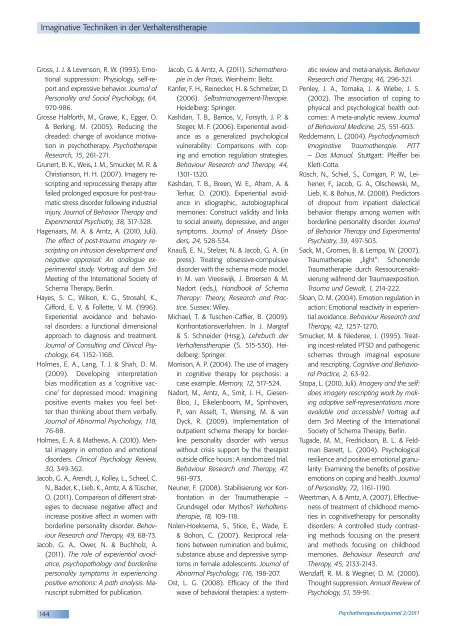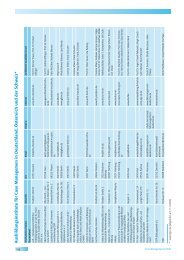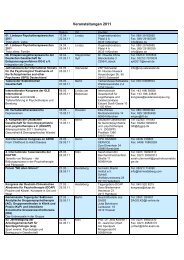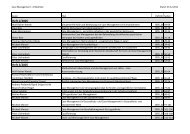Psychotherapeutenjournal 2/2011 - medhochzwei Verlag GmbH
Psychotherapeutenjournal 2/2011 - medhochzwei Verlag GmbH
Psychotherapeutenjournal 2/2011 - medhochzwei Verlag GmbH
Sie wollen auch ein ePaper? Erhöhen Sie die Reichweite Ihrer Titel.
YUMPU macht aus Druck-PDFs automatisch weboptimierte ePaper, die Google liebt.
Imaginative Techniken in der Verhaltenstherapie<br />
Gross, J. J. & Levenson, R. W. (1993). Emotional<br />
suppression: Physiology, self-report<br />
and expressive behavior. Journal of<br />
Personality and Social Psychology, 64,<br />
970-986.<br />
Grosse Haltforth, M., Grawe, K., Egger, O.<br />
& Berking, M. (2005). Reducing the<br />
dreaded: change of avoidance motivation<br />
in psychotherapy. Psychotherapie<br />
Research, 15, 261-271.<br />
Grunert, B. K., Weis, J. M., Smucker, M. R. &<br />
Christianson, H. H. (2007). Imagery rescripting<br />
and reprocessing therapy after<br />
failed prolonged exposure for post-traumatic<br />
stress disorder following industrial<br />
injury. Journal of Behavior Therapy and<br />
Experimental Psychiatry, 38, 317-328.<br />
Hagenaars, M. A. & Arntz, A. (2010, Juli).<br />
The effect of post-trauma imagery rescripting<br />
on intrusion development and<br />
negative appraisal: An analogue experimental<br />
study. Vortrag auf dem 3rd<br />
Meeting of the International Society of<br />
Schema Therapy, Berlin.<br />
Hayes, S. C., Wilson, K. G., Strosahl, K.,<br />
Gifford, E. V. & Follette, V. M. (1996).<br />
Experiential avoidance and behavioral<br />
disorders: a functional dimensional<br />
approach to diagnosis and treatment.<br />
Journal of Consulting and Clinical Psychology,<br />
64, 1152-1168.<br />
Holmes, E. A., Lang, T. J. & Shah, D. M.<br />
(2009). Developing interpretation<br />
bias modification as a ‘cognitive vaccine’<br />
for depressed mood: Imagining<br />
positive events makes you feel better<br />
than thinking about them verbally.<br />
Journal of Abnormal Psychology, 118,<br />
76-88.<br />
Holmes, E. A. & Mathews, A. (2010). Mental<br />
imagery in emotion and emotional<br />
disorders. Clinical Psychology Review,<br />
30, 349-362.<br />
Jacob, G. A., Arendt, J., Kolley, L., Scheel, C.<br />
N., Bader, K., Lieb, K., Arntz, A. & Tüscher,<br />
O. (<strong>2011</strong>). Comparison of different strategies<br />
to decrease negative affect and<br />
increase positive affect in women with<br />
borderline personality disorder. Behaviour<br />
Research and Therapy, 49, 68-73.<br />
Jacob, G. A., Ower, N. & Buchholz, A.<br />
(<strong>2011</strong>). The role of experiential avoidance,<br />
psychopathology and borderline<br />
personality symptoms in experiencing<br />
positive emotions: A path analysis. Manuscript<br />
submitted for publication.<br />
144<br />
Jacob, G. & Arntz, A. (<strong>2011</strong>). Schematherapie<br />
in der Praxis. Weinheim: Beltz.<br />
Kanfer, F. H., Reinecker, H. & Schmelzer, D.<br />
(2006). Selbstmanagement-Therapie.<br />
Heidelberg: Springer.<br />
Kashdan, T. B., Barrios, V., Forsyth, J. P. &<br />
Steger, M. F. (2006). Experiential avoidance<br />
as a generalized psychological<br />
vulnerability: Comparisons with coping<br />
and emotion regulation strategies.<br />
Behaviour Research and Therapy, 44,<br />
1301-1320.<br />
Kashdan, T. B., Breen, W. E., Afram, A. &<br />
Terhar, D. (2010). Experiential avoidance<br />
in idiographic, autobiographical<br />
memories: Construct validity and links<br />
to social anxiety, depressive, and anger<br />
symptoms. Journal of Anxiety Disorders,<br />
24, 528-534.<br />
Knauß, E. N., Stelzer, N. & Jacob, G. A. (in<br />
press). Treating obsessive-compulsive<br />
disorder with the schema mode model.<br />
In M. van Vreeswijk, J. Broersen & M.<br />
Nadort (eds.), Handbook of Schema<br />
Therapy: Theory, Research and Practice.<br />
Sussex: Wiley.<br />
Michael, T. & Tuschen-Caffier, B. (2009).<br />
Konfrontationsverfahren. In J. Margraf<br />
& S. Schneider (Hrsg.), Lehrbuch der<br />
Verhaltenstherapie (S. 515-530). Heidelberg:<br />
Springer.<br />
Morrison, A. P. (2004). The use of imagery<br />
in cognitive therapy for psychosis: a<br />
case example. Memory, 12, 517-524.<br />
Nadort, M., Arntz, A., Smit, J. H., Giesen-<br />
Bloo, J., Eikelenboom, M., Spinhoven,<br />
P., van Asselt, T., Wensing, M. & van<br />
Dyck, R. (2009). Implementation of<br />
outpatient schema therapy for borderline<br />
personality disorder with versus<br />
without crisis support by the therapist<br />
outside office hours: A randomized trial.<br />
Behaviour Research and Therapy, 47,<br />
961-973.<br />
Neuner, F. (2008). Stabilisierung vor Konfrontation<br />
in der Traumatherapie –<br />
Grundregel oder Mythos? Verhaltenstherapie,<br />
18, 109-118.<br />
Nolen-Hoeksema, S., Stice, E., Wade, E.<br />
& Bohon, C. (2007). Reciprocal relations<br />
between rumination and bulimic,<br />
substance abuse and depressive symptoms<br />
in female adolescents. Journal of<br />
Abnormal Psychology, 116, 198-207.<br />
Ost, L. G. (2008). Efficacy of the third<br />
wave of behavioral therapies: a system-<br />
atic review and meta-analysis. Behavior<br />
Research and Therapy, 46, 296-321.<br />
Penley, J. A., Tomaka, J. & Wiebe, J. S.<br />
(2002). The association of coping to<br />
physical and psychological health outcomes:<br />
A meta-analytic review. Journal<br />
of Behavioral Medicine, 25, 551-603.<br />
Reddemann, L. (2004). Psychodynamisch<br />
Imaginative Traumatherapie. PITT<br />
– Das Manual. Stuttgart: Pfeiffer bei<br />
Klett-Cotta.<br />
Rüsch, N., Schiel, S., Corrigan, P. W., Leihener,<br />
F., Jacob, G. A., Olschewski, M.,<br />
Lieb, K. & Bohus, M. (2008). Predictors<br />
of dropout from inpatient dialectical<br />
behavior therapy among women with<br />
borderline personality disorder. Journal<br />
of Behavior Therapy and Experimental<br />
Psychiatry, 39, 497-503.<br />
Sack, M., Gromes, B. & Lempa, W. (2007).<br />
Traumatherapie „light“: Schonende<br />
Traumatherapie durch Ressourcenaktivierung<br />
während der Traumaexposition.<br />
Trauma und Gewalt, 1, 214-222.<br />
Sloan, D. M. (2004). Emotion regulation in<br />
action: Emotional reactivity in experiential<br />
avoidance. Behaviour Research and<br />
Therapy, 42, 1257-1270.<br />
Smucker, M. & Niederee, J. (1995). Treating<br />
incest-related PTSD and pathogenic<br />
schemas through imaginal exposure<br />
and rescripting. Cognitive and Behavioral<br />
Practice, 2, 63-92.<br />
Stopa, L. (2010, Juli). Imagery and the self:<br />
does imagery rescripting work by making<br />
adaptive self-representations more<br />
available and accessible? Vortrag auf<br />
dem 3rd Meeting of the International<br />
Society of Schema Therapy, Berlin.<br />
Tugade, M. M., Fredrickson, B. L. & Feldman<br />
Barrett, L. (2004). Psychological<br />
resilience and positive emotional granularity:<br />
Examining the benefits of positive<br />
emotions on coping and health. Journal<br />
of Personality, 72, 1161-1190.<br />
Weertman, A. & Arntz, A. (2007). Effectiveness<br />
of treatment of childhood memories<br />
in cognitivetherapy for personality<br />
disorders: A controlled study contrasting<br />
methods focusing on the present<br />
and methods focusing on childhood<br />
memories. Behaviour Research and<br />
Therapy, 45, 2133-2143.<br />
Wenzlaff, R. M. & Wegner, D. M. (2000).<br />
Thought suppression. Annual Review of<br />
Psychology, 51, 59-91.<br />
<strong>Psychotherapeutenjournal</strong> 2/<strong>2011</strong>











